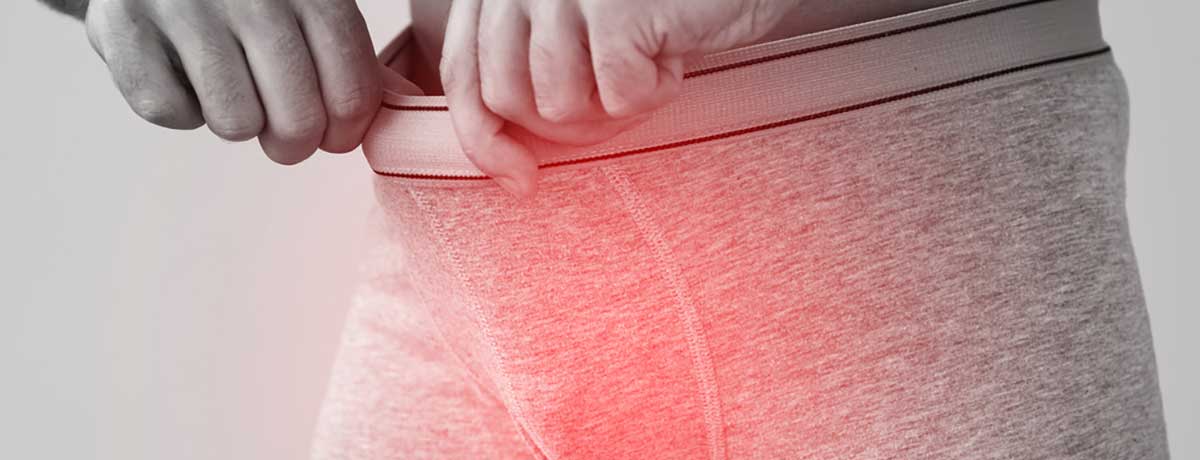Friction Blister overview
What to expect in this article?
In this article, an experienced STD doctor, Dr. Slava Fuzayloff, will explain from a practical standpoint how to tell the difference between a friction burn (or blister) in the genital area and other conditions that look similar (e.g., herpes, allergic rash, and fungal infection).
Before jumping into comparisons, we'll review the classic signs and symptoms of friction burns (or blisters) and their timing.
Let's proceed.
Terminology (friction burn and fiction blister)
People use both terms - friction burn and friction blister - frequently and interchangeably. But there is a difference. These two things represent different stages of the same process - friction trauma to the skin. Friction blister is more advanced damage of the skin - that's why a blister forms. The genital area, like other areas of thin skin, mainly gets friction burn.
What friction burn and friction blister are
Friction burn (or blister) is intraepidermal damage caused by skin repeatedly rubbing on another object.
- "Intraepidermal" means the burn forms in the top, epidermal, layer of the skin.
- Skin has multiple layers: the stratum corneum, epidermis, and dermis. The epidermis is part of the top layer of skin.
| Stratum corneum |
|---|
| Epidermis |
| Dermis |
- The degree of skin damage depends on the force of the friction.
Where in the genitals friction burn is most common?
Moist skin produces more friction than dry or wet skin. These are the genital areas that most commonly get friction burn:
- Shaft of the penis (male)
- Head of the penis (male)
- Pubic area (male and female)
- Vagina entrance (female)
- Vulvar area (female)
Most common causes of penis friction burn
- Vigorous masturbation
- Intense, prolonged intercourse
- Wearing tight-fitting clothing during exercise
- Vigorous drying with a coarse towel after a shower
Genital friction burn (and blister) signs, symptoms, and progression
The following are the stages that skin in any part of the body goes through after friction trauma:
1. The area that was rubbed will become red and swollen and begin burning almost immediately.
2. Progression to a blister can happen within hours. The blister is usually very tense, with clear fluid inside it. (But friction blisters rarely form in the genital area.)
3. The blister might rupture immediately after it forms (if it's located very close to the surface), or it might last for a few days (if it forms deeper in the skin).
4. It might take one week for a burn or blister to get better without scarring.
Diagnosing friction burn (or blister)
Friction burn or blister is a clinical diagnosis and usually does not require any testing, such as a biopsy. This means that what's most important in diagnosing friction burn (or blister) are the following:
- History
-
- The patient should be asked about recent rubbing trauma.
- Symptoms
-
- Immediate pain following friction trauma is likely.
- Visual exam of the area
Genital friction burn photos
Here we will show images of classic friction burn (borrowed from other sites on the internet) along with explanations of the main practical points.
Image 1.
Here's a common area of skin burn in uncircumcised males caused by wearing tight underwear while exercising. Note the visible skin damage with minimal redness and swelling.
Image source: https://patient.info/forums/discuss/friction-burn-or-valentine-s-day-gift-755849
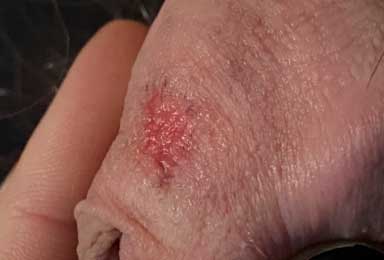
Image 2.
Again, here you can see visible skin damage with minimal redness and swelling. A blister has formed.
Image source: https://patient.info/forums/discuss/friction-burn-or-valentine-s-day-gift-755849
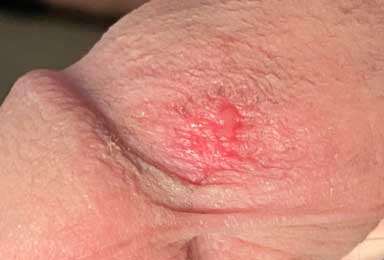
Image 3.
Once again, note the visible skin damage due to friction, with minimal redness and swelling.
Image source: https://www.medicalnewstoday.com/articles/325533
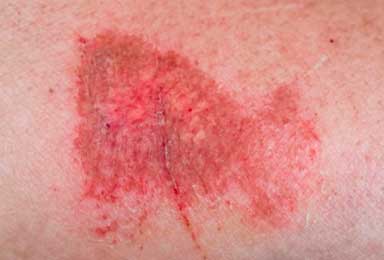
Image 4.
The vagina opening is a common area for friction burn in females.
Image source: https://www.firstderm.com/sex-skin-rashes-can-signify-partner-cheated
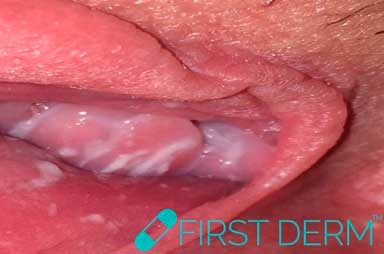
Is it a genital friction burn or herpes?
How to differentiate Herpes from Friction burn. By STD expert.
When a doctor wants to differentiate between genital friction burn and a newly acquired herpes lesion, the history of the rash, its appearance, and what is seen on physical examination are all important.
Let's talk about each of these in more detail!
History of the rash (friction burn vs. herpes)
The history of the rash includes the following information:
- What caused the rash, or what event preceded the rash's appearance?
- How much time passed after the suspected cause before symptoms appeared?
- Did nonspecific systemic symptoms precede the rash's appearance (i.e., during a prodrome period)?
What caused the rash, or what event preceded the rash's appearance?
Herpes
People usually get herpes rash after having sex with a new sexual partner.
Friction burn
Friction burn rash occurs because of mechanical damage to the skin. Here are some possible causes:
- Intense skin friction during sex or masturbation
- Prolonged sex
- Insufficient lubrication during sex or masturbation
How much time passed before symptoms appeared?
The incubation period - the amount of time that passed before the appearance of symptoms - is very important in differentiating between herpes and friction burn.
Herpes
It takes from 1 day to 21 days (2 to 4 days on average) for a herpes skin lesion to appear after the contact that caused it.
Friction burn
Unlike herpes, friction burn appears right after the triggering event (e.g., intense rubbing).
What caused the rash, or what event preceded the rash's appearance?
The presence of prodrome symptoms (symptoms preceding the rash's appearance) is another important factor that helps differentiate between herpes and friction burn.
- Herpes usually presents with systemic symptoms and signs, such as fever, lymph node enlargement, overall weakness, and flu-like symptoms, that precede the appearance of the rash.
- Friction burn rash, on the other hand, does not have any preceding systemic symptoms.
Visual examination of the rash (friction burn vs. herpes)
When deciding what kind of rash someone has-friction burn or herpes-it's important to pay attention to the following:
- The location of the rash
- The rash's appearance and progression
Location of the rash
While both friction burn and herpes can affect the same general area, they affect different parts of it.
Herpes
Herpes lesions usually appear on the part of the skin that borders the mucosa (the herpes virus prefers thin, moist skin areas):
- Base of the penis
- Scrotum
- Inner vulva
Friction burn
Friction burn can affect any area that is commonly rubbed (usually protruding or commonly used surfaces), regardless of skin thickness:
- Glans penis
- Penis shaft
- Vagina opening
- Vulva
- Pubic area
Rash appearance and progression
Unlike herpes rash, which changes appearance over time, friction burn rash remains unchanged until it heals.
Herpes skin changes
Herpes rash goes through the following stages:
- The skin area tingles (there's a prickly feeling).
- Redness appears.
- Blisters form close together on the same red base.
- The roof of the blister comes off, forming multiple individual sores.
- The sores heal without scarring.
Friction burn skin appearance
- The affected skin turns red, forming one small sore (unlike the multiple sores of herpes).
- Swelling is minimal.
- The sore area heals within one week without scarring.
- Blisters rarely form in the genital area (as is true of any thin area of the skin).
Is it a genital friction burn or allergic rash?
The following must be considered when differentiating between friction burn and allergic rash in the genital area:
- History of the rash
- Rash location and size
- Symptoms
- The rash's appearance during physical examination
Let's talk about each of these in more detail!
History of the rash (friction burn vs. allergic rash)
The history of the rash-the activity that occurred before the rash appeared-is an important differentiating point.
Friction burn happens after one of these:
- Intense sex or masturbation
- Wearing tight underwear
On the other hand, here's when allergic rash might appear:
- After using a new skin care product, new condom, new lubricant, etc.
- A person can develop an allergic reaction to a product they've used for a long time, but an allergic reaction to a new product is more common.
Timing (friction burn vs. allergic rash)
By timing of the rash, we mean how soon the rash appeared after the triggering event.
Friction burn
Friction burn might hurt and show up immediately or a few hours after the event.
Allergic rash
Unlike friction burn, an allergic skin rash is usually a delayed hypersensitivity reaction that can take 24 to 72 hours to appear.
Rash location and size (friction burn vs. allergic rash)
Friction burn rash
Friction burn rash usually appears on protuberant areas (glans of the penis) or the area that was rubbed (the shaft of the penis or the vaginal opening). Friction burn rash is small in size.
Allergic rash
- Allergic rash can affect any skin area that came into contact with the trigger.
- The affected area is usually much bigger. It is very rare to see one small spot of allergic rash.
Symptoms (friction burn vs. allergic rash)
The symptoms are one of the most important factors in differentiating between friction burn and allergic rash.
Friction burn
- The main symptom of friction burn is pain over the area that worsens when it's touched.
Allergic rash
- The main symptom of allergic rash is itch. Burning can follow the itch, but itch is still the predominant symptom.
Rash appearance (friction burn vs. allergic rash)
Friction burn rash
A friction burn rash usually has the following appearance:
- Visible superficial skin damage (the top skin layer is gone)
- Redness
- Minimal swelling
- Very sensitive to touch (touch triggers more discomfort)
Allergic rash
Unlike friction burn, allergic rash inflammation is usually more significant:
- Hot to the touch
- Very red
- Significant swelling
- Scaling and thickening of the skin can be visible with prolonged exposure to allergy trigger.
Genital friction burn vs. fungal rash (jock itch or tinea)
To differentiate friction burn from fungal rash, one must consider the following:
- History of the rash
- Rash location and size
- Symptoms
- The rash's appearance during physical examination
Let's talk about each of these in more detail!
History of the rash (friction burn vs. fungal rash)
In differentiating between friction burn rash and fungal rash, the history of the rash-especially the person's activity before the rash appeared-is important.
Friction burn happens after one of these:
- Intense sex or masturbation
- Wearing tight underwear
Fungal rash
Yeast (fungal rash) thrives in moist areas where skin touches skin. Skin folds retain heat and moisture, providing an environment well suited for yeast infection. The following are predisposing factors for genital skin fungal infection:
- Poor hygiene
- Being overweight
- Hot, humid weather
- Intense exercise with sweating, with the area remaining wet for some time
Timing (friction burn vs. fungal rash)
How soon the rash appeared after the triggering event is what we mean by the timing of the rash.
Friction burn rash
Friction burn rash might hurt and become visible immediately or a few hours after the event that caused it.
Fungal rash
Fungal rash usually takes about 4 days to appear on the genital area, but may take up to 10 days.
Rash location and size (friction burn vs. allergic rash)
Friction burn rash
Friction burn rash usually appears on protuberant areas (glans of the penis) or the area that was rubbed (the shaft of the penis or the vaginal opening). Friction burn rash is small in size.
Allergic rash
- Allergic rash can affect any skin area that came into contact with the trigger.
- The affected area is usually much bigger. It is very rare to see one small spot of allergic rash.
Rash location and size (friction burn vs. fungal rash)
Friction burn rash
Friction burn rash usually appears on protruding surfaces (glans of the penis) or an area that was rubbed (penis shaft or vaginal opening) during sex or exercise. Friction burn rash is small in size.
Fungal rash
- Fungal rash usually occurs in warm, moist areas (e.g., uncircumcised penis head, skin fold areas).
- The affected area is usually much bigger, affecting the entire moist area, that with friction burn rash.
- Fungal rash is usually one-sided (even when both sides get wet).
Symptoms (friction burn vs. fungal rash)
One of the most important differentiating points between genital friction burn and fungal rash is the symptoms-what people feel with the rash.
Friction burn rash
- The main symptom of friction burn is pain over the area that is aggravated by touch.
Fungal rash
- The main symptom of fungal rash is a mild itch.
Rash appearance (friction burn vs. fungal rash)
Friction burn
Friction burn rash usually looks like superficial skin damage-red, minimally swollen, and very sensitive to the touch.
Fungal rash
- Fungal rash inflammation is more intense and for that reason very red.
- The borders of the rash are well defined (clearly separate from normal skin).
- At the outside borders of the rash, the skin can be scaly.
